How to Make a Subway Map with John Tauranac
Hear from an author and map designer who has been creating maps of the NYC subway, officially and unofficially, for over forty years!



The Replica of Mount Vernon in Prospect Park. Image from Brooklyn Historical Society via Prospect Park Alliance
On April 1st and April 2nd, Prospect Park in Brooklyn will celebrate its 150th Anniversary in what the Prospect Park Alliance is calling a “blowout weekend” of events. All weekend long, enjoy the start of the spring season with an Opening Day Parade and Fair, an exhibition 1860s ballgame, running and walking tours, and the first Smorgasburg of the season.
In celebration, we worked with the Prospect Park Alliance to put together a historical look at the lost and never built structures of Prospect Park, opened in 1867. This piece builds upon our previous exploration into the secrets of Prospect Park.

Image from Brooklyn Historical Society via Prospect Park Alliance
In 1932, Robert Moses had a replica of Mount Vernon built in Prospect Park to to mark the 200th anniversary of George Washington’s birth. The building, constructed by Sears, Roebuck & Company (who also delivered another replica to the Exposition Coloniale Internationale in Paris in 1931 which is still standing in the country) and designed by architect Charles K. Bryant, lasted lasted a mere two years before being torn down. The house was located at the base of Lookout Hill on the Peninsula of the Lake.
Prospect Park Alliance reports that the exhibit was “complete with a Presidential impersonator. From [1932] until 1934, when it was taken down, crowds lined up to pay admission to see the elaborate gardens and meticulously recreated interiors.”
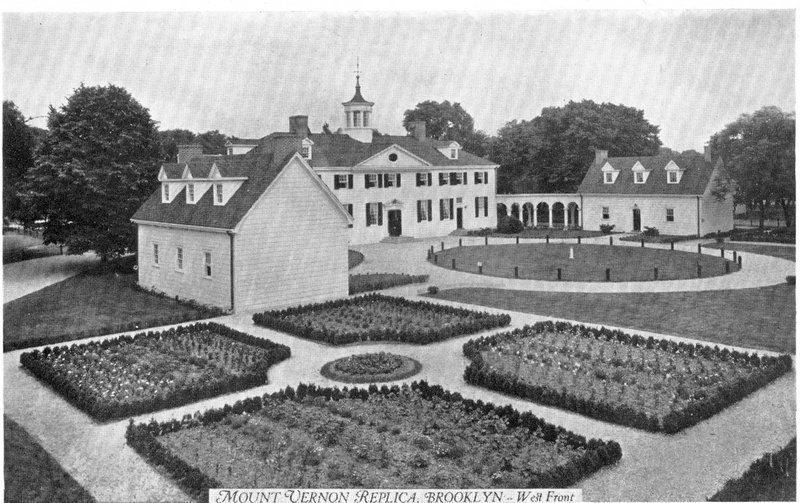
Image via Prospect Park Archives/Bob Levine Collection
The Mount Vernon replica in Prospect Park is one of the shortest lived buildings in NYC.

The Dairy in Prospect Park. Photo from New York Public Library
The Dairy, designed by Frederick Law Olmsted and Calvert Vaux as part of the original design of the Park, was located on Sullivan Hill, just across from the Long Meadow. This cozy farmhouse attracted Park picnickers who stopped by to purchase glasses of fresh milk provided by the half-dozen cows that grazed on Long Meadow grasses. Pre-pasteurization, fresh milk was a near-delicacy for Brooklyn residents, accustomed to a gray, watery variety of milk produced by most city cows. According to David P. Colley in the book Prospect Park: Olmsted and Vaux’s Brooklyn Masterpiece, the Dairy also served delicacies corned-beef and tongue sandwiches, bread and cheese, sardines, picked oysters, biscuits, nuts, sweets, ice cream, and macaroons.
In 1935, the Dairy, in disrepair, was removed by Parks Commissioner Robert Moses.
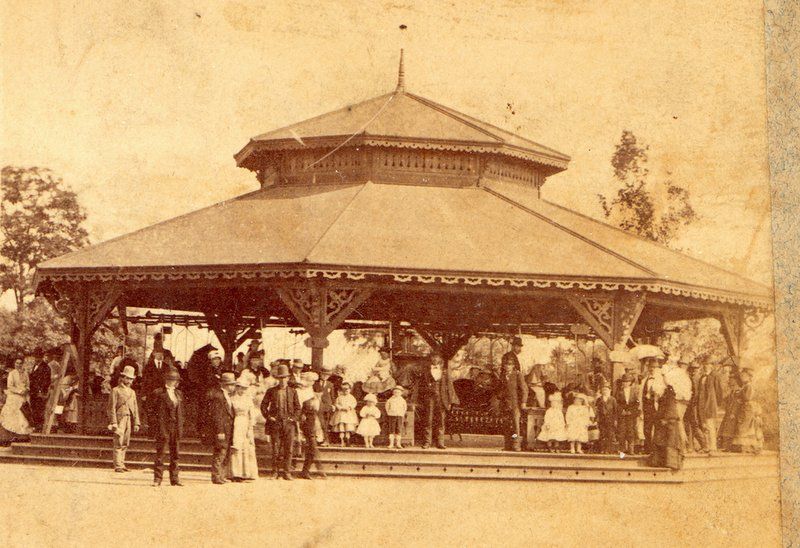
Carousel in 1885, Prospect Park Archives/Herbert Mitchell Collection
The Park’s first carousel was erected in 1874 in the northeast corner of the Park in the Rose Garden and the Vale of Cashmere, an area known as the Children’s Playground at the time. According to David P. Colley in the book Prospect Park: Olmsted and Vaux’s Brooklyn Masterpiece, the carousel was the garden’s “greatest attraction.”
A small, 24-horse structure, it was propelled by an old, white, blind horse that worked in the windowless cellar, and cost three cents per ride. An organ projected music while the ride went round and round. Colley writes that the “lack of shade and the heat in the Vale of Cashmere eventually forced closure of the playground around 1890…But the Carousel was so popular that the park board recommended that a second one be built near the picnic grounds.” The Children’s Playground area was redesigned dramatically by McKim, Mead & White later into the Vale of Cashmere.
The present day Carousel in the Park’s Children’s Corner was brought to the Park in 1952 from Coney Island, and is over 100 years old.

The Thatched Shelter. Image via Prospect Park Archives
The Thatched Shelter was built 1874 on a low hill at the north end of Long Meadow, just inside the Grand Army Plaza entrance. Colley calls this building Prospect Park’s “most prominent shelter.” This Adirondack-style rustic shelter was visually in keeping with the many rustic bridges, platforms and arbors designed by Calvert Vaux for the Park, and provided views out over the meadow. A fire destroyed this structure in 1937.
These thatched and rough-hewn features made of gnarled birch, locust or oak were visual respites from the brick and stone that accompanied city-life.An old photograph shows a horse-drawn cart carrying a barrel, which sprinkled water to make the road dust manageable.
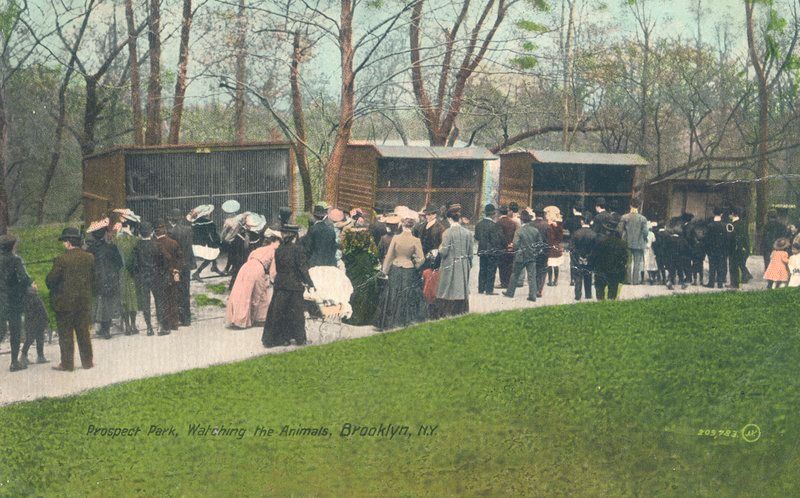
Long before the Prospect Park Zoo was constructed, the Park was home to its own menagerie. Located near the Long Meadow, the menagerie opened in 1890 with a bear pit, and quickly grew to include elephants, deer, lions, monkeys and birds, housed in cages and pens. According to Colley, the collection of animals included the “diabolical cinnamon bear ‘Spite,’ who in 1902 had been transferred from the New York Zoological Park.”
The menagerie was inadequately funded and generally in a dilapidated state. When the official Prospect Park Zoo was constructed in 1935, the Park’s animals were moved and menagerie was demolished.
Want to learn more about the history of Prospect Park? Join us for an upcoming Secrets of Prospect Park Walking Tour, and keep reading for more lost or never built structures!
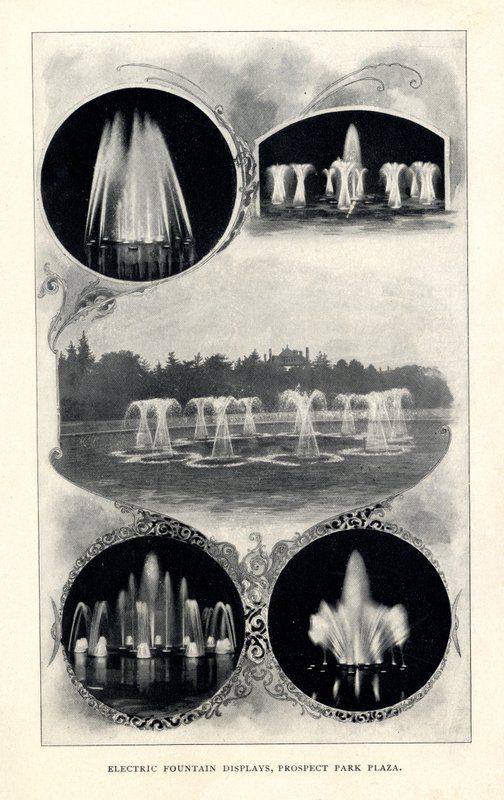
Image via Prospect Park Archives
The fanciful fountain behind the Soldiers’ and Sailors’ Memorial Arch in Grand Army Plaza is the fourth fountain in that location. Earlier models were installed in 1873 and 1897. The former featured 24 stained-glass windows lit by gas jets, and the latter boasted electric lights and dancing jets of water controlled by a subterranean operator. That fountain was demolished during the construction of the subway, and was replaced with Bailey Fountain in 1932.
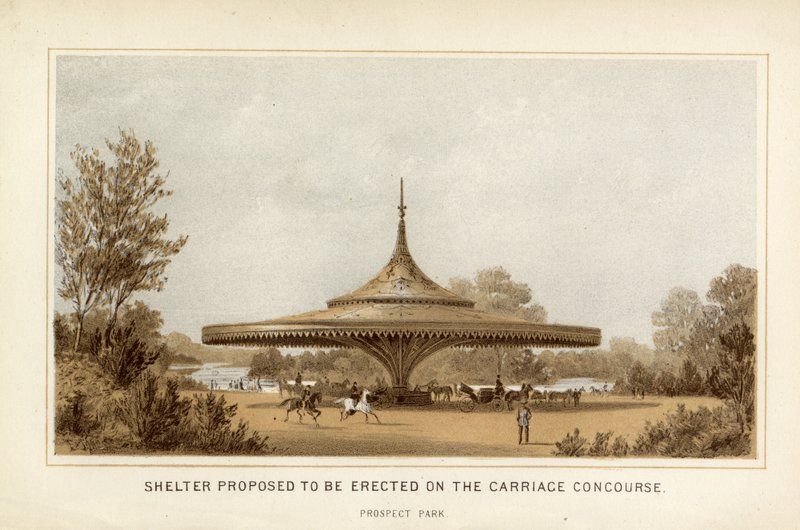
Image courtesy Prospect Park Alliance
The panic of 1873 scaled down the plans for Prospect Park, allowing only ongoing projects to be completed with the financial situation lasting a decade. This meant that structures designed by Calvert Vaux like a carriage concourse were never completed. The Carriage Concourse was intended to have a 100 foot canopy that would offer shade for horses and carriages. A shelter next to the concourse also remained unbuilt.
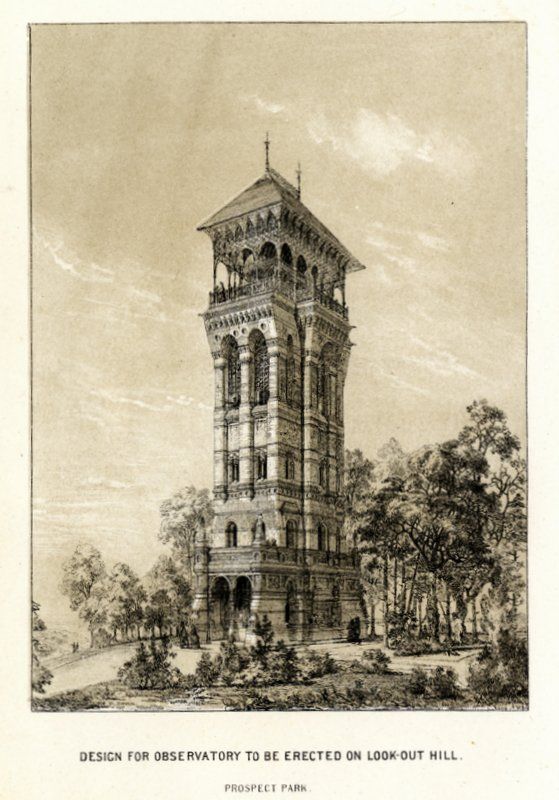
Image courtesy Prospect Park Alliance
Another unbuilt work by Calvert Vaux was a stone observation tower modeled after Venice’s Piazza St. Marco bell tower that would have been located atop Lookout Hill. Colley states that this would have been “the park’s most visible Landmark.”
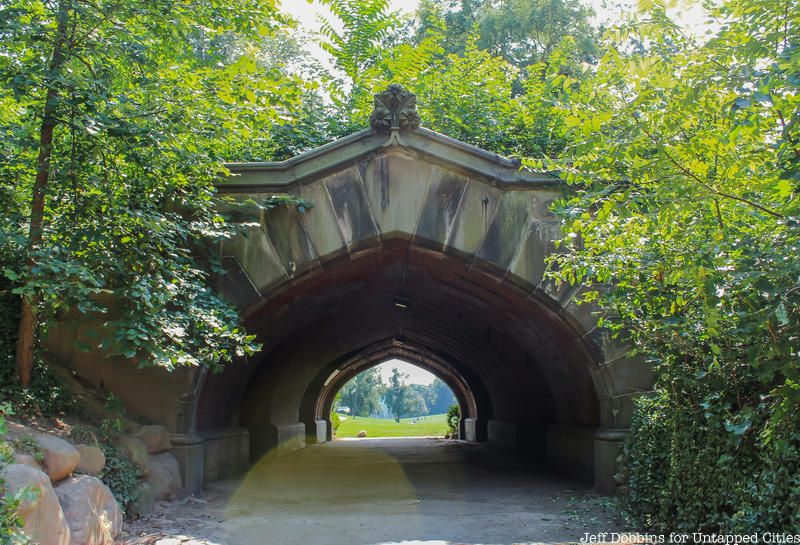
The grandest of Vaux’s unbuilt structures was the Refectory, a restaurant Colley says would have been a “major focal point” of the park. Colley writes that “this restaurant was designed to be approached from the Concert Grove and Lookout Hill and had terraces cascading down to the Lake to provide additional access for boaters and skaters.”
In addition to the Refectory, the observation tower and the carriage concourse, additional archways were also removed from the plan for Prospect Park.
Want to learn more about the history of Prospect Park? Join us for an upcoming Secrets of Prospect Park Walking Tour, and keep reading for more lost or never built structures!
Next, discover the Top 12 Secrets of Prospect Park.
Subscribe to our newsletter